Quality control is one of the most critical aspects of food production: inspecting, testing, and grading of fruit and vegetables ensures that our food is safe, fresh, and meets food safety standards. In today’s globally interconnected food economy, quality control tests are performed at several stages throughout the supply chain, from cultivation and harvesting to processing, packaging, transportation, and distribution.
Pre-harvest tests help growers assess the needs of their crops, make decisions about nutrition or pesticide applications, determine ideal harvest windows, and support farm management decisions of all kinds.
Starch is a type of carbohydrate found in various plants, including apples. During the ripening process of apples, the starch gradually converts into sugar. The level of starch in an apple is used as a metric to determine its ripeness, with higher starch levels indicating a less ripe fruit. A critical preharvest test in the apple industry, the starch iodine test is the most common method of calculating ideal harvest windows for apples going into storage.
Harvest indices:
Quality control metrics that can determine a fruit’s suitability for harvest and long-term storage are called harvest indices.
Brix, or Degrees Brix, is a measure of the total soluble solids present in the fruit. Total Soluble Solids (TSS) are primarily made up of sugar (usually at least 80%) but may also include soluble acids like citric acid, vitamins like A and C, or other compounds. Generally though, when we talk about Brix values, it's about sugar. Brix testing is done at various points in the fruit's lifecycle, in preharvest testing it is often used as part of a maturity index. In the post-harvest world, Brix testing is used primarily to objectively assess flavor and sweetness of produce.
Color changes as fruit matures and ripens, and judging the ripeness of fruit by the external color is one of the oldest methods in the book. Different crops have different ripening processes, and the external color of the fruit isn’t always the most important metric. Internal color assessment can be used to track maturity and ripeness in types of fresh produce that don’t change color externally.
Color is also one of the most important factors for consumer acceptance of produce, so consistent color metrics are a critical part of a quality control assessment. Fruit color can impact both the grade and price of harvested fruit, and in some cases, postharvest color development needs to be induced.
What is degreening?
A citrus fruit ripens and acquires that signature lemon yellow, this is the process known as “degreening”, where lemons lose their green chlorophyll during the cold nights. In some climates, the degreening process may not start until well after the fruit is already mature, and needs to be induced through post-harvest treatments.
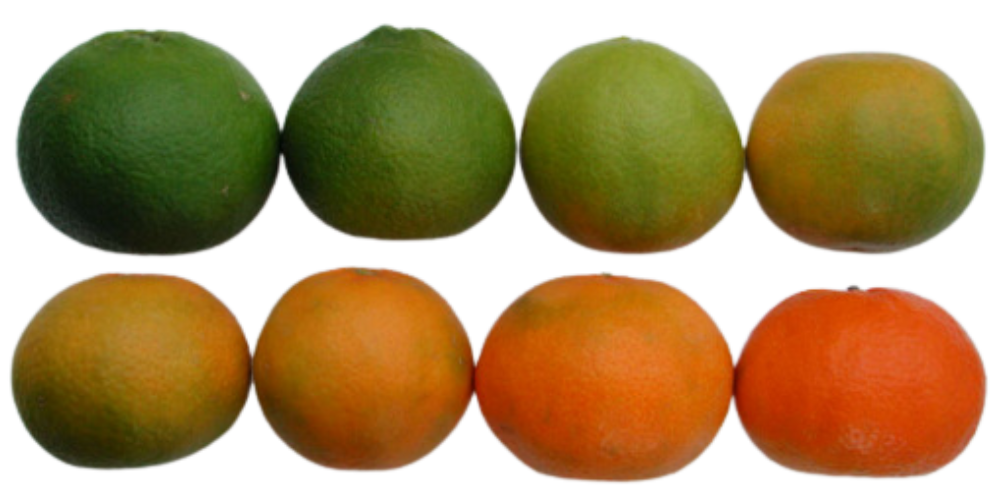
Dry matter measurement represents the total solids in a piece of fruit, including starches, proteins, sugars, fiber, and carbohydrates, a dry matter measurement is most simply explained as the total weight of the fruit, minus the water content. Dry matter accumulation changes throughout the fruit growth cycle and is used as a maturity indicator in some climacteric fruits.
Titratable acidity measures the total acid content in food and is one of the most important maturity and flavor metrics in the citrus industry. In less mature fruit, there is a higher acid-to-sugar ratio, but as the fruit ripens and more starch is converted into sugar, mature fruits develop a higher sugar-to-acid ratio creating the sweet taste consumers prefer.
Ethylene (C2H4) is a naturally occurring plant hormone, often called the fruit-ripening hormone. To test ethylene gas concentration, fruit are sealed in an airtight container, allowing the ethylene to build up. After some time has passed, the gas inside the container is extracted and measured with a gas chromatograph. Gas chromatography is used in analytical chemistry to separates and analyzes gas compounds. In apples, a gas sample can be taken by inserting a needle directly into the core of the apple.
Climacteric vs Non-Climacteric Fruit
Climacteric fruit like apples continue to ripen after they are picked. These fruit will continue to ripen in storage or during transportation after harvest. Climacteric fruit produce more ethylene than non-climacteric fruit like strawberries, which won't become fully ripe after separation from the plant.
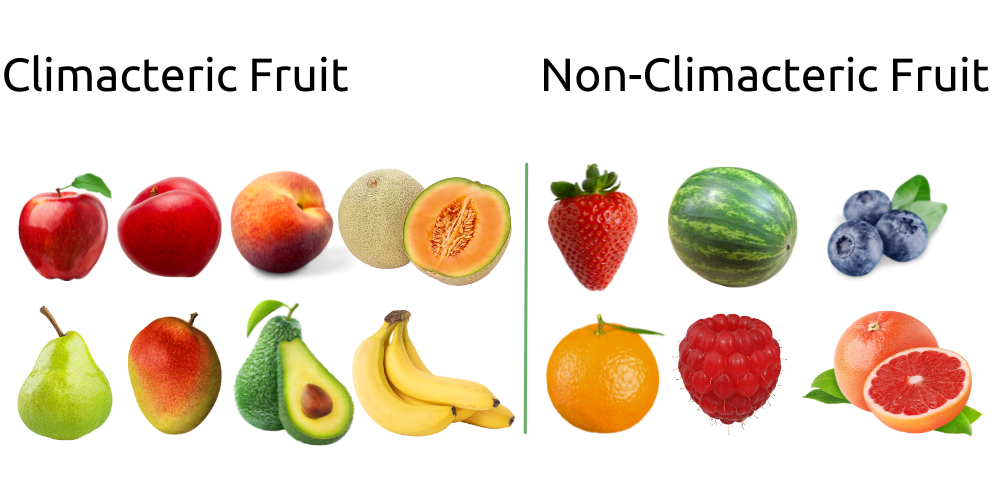
Firmness testing assesses the internal pulp firmness of a given fruit, which corresponds to the crisp, crunchy experience of eating fresh fruit. The main method of testing firmness is using a penetrometer, which is a device that measures the pressure and compression needed to puncture the flesh of the fruit.
Near-Infrared (NIR) testing and the specialized DA meter are newer technology in fresh produce quality control. They use non-destructive quality control methods, making them an attractive option for in field and higher speed testing. NIR spectroscopy quantifies multiple internal properties simultaneously, such as Brix (soluble sugars), dry matter, and organic acids, by analyzing how the produce absorbs specific wavelengths of light. The DA meter is a specific NIR tool that measures chlorophyll content using the Index of Absorbance Difference (IAD) to objectively monitor fruit ripeness and maturity. Both offer fast, objective results about fruit maturity and quality that reduce waste, enabling efficient sampling and ensuring consistency across the supply chain.
Defects or damage to produce affects the grade and value, but can also have serious impacts on the shelf life and storage of harvested products. Defects can be grouped into a few categories:
Growing defects occur as a result of environmental factors that affect the shape, size, appearance, or texture of the fruit. Some of the most common growth defects are:
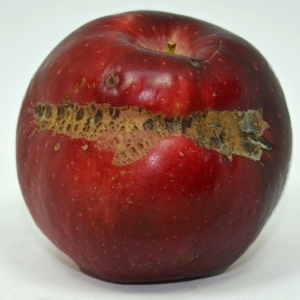
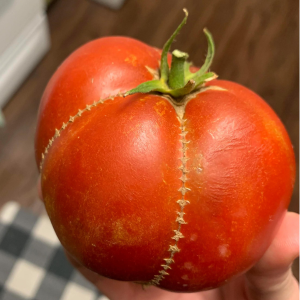
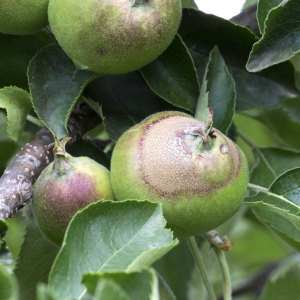
Picking defects occur during harvest and are typically caused by rough handling. While many harvest defects may appear small or innocuous, any wound or damage to fruit may leave it open to a secondary infection or infestation.
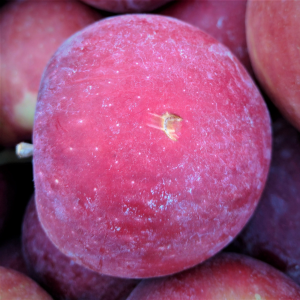
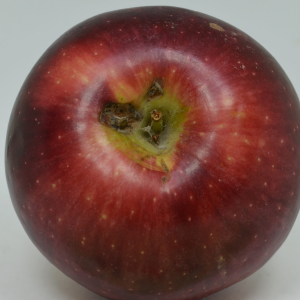
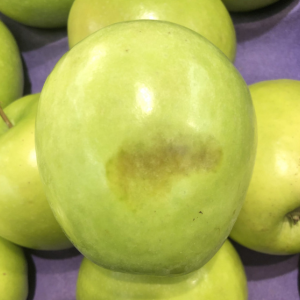
Even after the harvest, transportation and sorting are done, stored fruit and vegetables aren’t immune to storage damage. Climate-controlled storage presents its own set of issues and risks. Storage disorders affect produce in long term storage and may produce undesirable flavors, affect texture, or even cause visible damage. These disorders include various kinds of storage rot and fungal development, as well as other physiological disorders.
Produce is inspected for various quality parameters, including appearance, size, shape, color, firmness, and absence of defects or flaws. Grading involves categorizing the produce into different classes or categories based on these quality attributes. Quality control measures adhere to specific standards set by regulatory bodies, industry associations, or market requirements. These standards define the acceptable levels of quality for various produce types and help ensure consistency and consumer satisfaction.
Sensory evaluation by a human tester is the simplest and most common starting place when it comes to quality control for fresh produce. These quality checks rely on the senses of sight, smell, touch, and sometimes taste to evaluate the quality and freshness of produce. Sensory evaluation can provide valuable information about the qualitative characteristics of fruits and vegetables, helping to determine their ripeness, texture, and overall desireability for sale. During sensory evaluation, quality control inspectors examine the produce visually, looking for any external defects such as discoloration, bruises, cuts, or blemishes. They assess the overall appearance, including color, size, shape, and uniformity, as these attributes are often associated with quality and consumer preference.
While sensory evaluation is a valuable tool, it's important to acknowledge that it has inherent subjectivity. The perception of sensory attributes can vary among individuals, and personal preferences may influence evaluations. To mitigate this subjectivity, sensory panelists undergo training to develop a common vocabulary and understanding of quality attributes. Standardized evaluation protocols and reference samples are often employed to minimize variability.
Croptracker develops agtech solutions for industry leaders. Located in Eastern Ontario, Canada, our mission is to make crop production safer, more efficient, and more profitable. Designed in partnership with fresh market producers and distributors, every tool we create is based on direct industry feedback.
Interested in learning more about Croptracker? Learn more about our Farm Management Software, or book a demonstration to schedule a meeting with our product experts.
Farm management is an umbrella term, covering a wide range of topics associated with running and maintaining a successful agricultural operation. Decision making, implementation, long term business strategy, sustainability, leadership, and organization management make up a large part of farm management, but the daily operations of running a farm like production practice activities, managing employees, applying pesticides, and harvest inventory tracking, make up a large component as well. Farm management’s goal, then, is to maximize production and profit in a given farming operation.
Business management is just one aspect of farm management, and a strong farm management strategy will include a business plan that takes into account the long term goals and risks related to your organization. A quality business plan should include a vision, mission, and a detailed breakdown of the resources needed to meet your goals.
Farm management companies may offer consulting services, site assessments, and even on site training to help growers improve their farm management strategies. Such strategies range from employee leadership training, to more traditional cost benefit analysis to maximize profit.
While there exist a variety of courses and training programs for farm management, many growers opt instead to invest in farm management software systems that can help them to collect data and track the metrics they need. Farm or agriculture management software are digital tools that help growers centralize their records, improve their productivity, and make better decisions for their farms. High quality farm management software will allow growers to better record, monitor, and view data in meaningful formats, and should provide users with farm analytics and reports at various stages of production.
Farm management has become more and more data centered, and being able to understand your data is just as important as having it recorded. Consolidating data into reports, creating long term plans based on trends in yield and revenue, and having data ready and available at audit time are all crucial aspects of a farm management strategy.
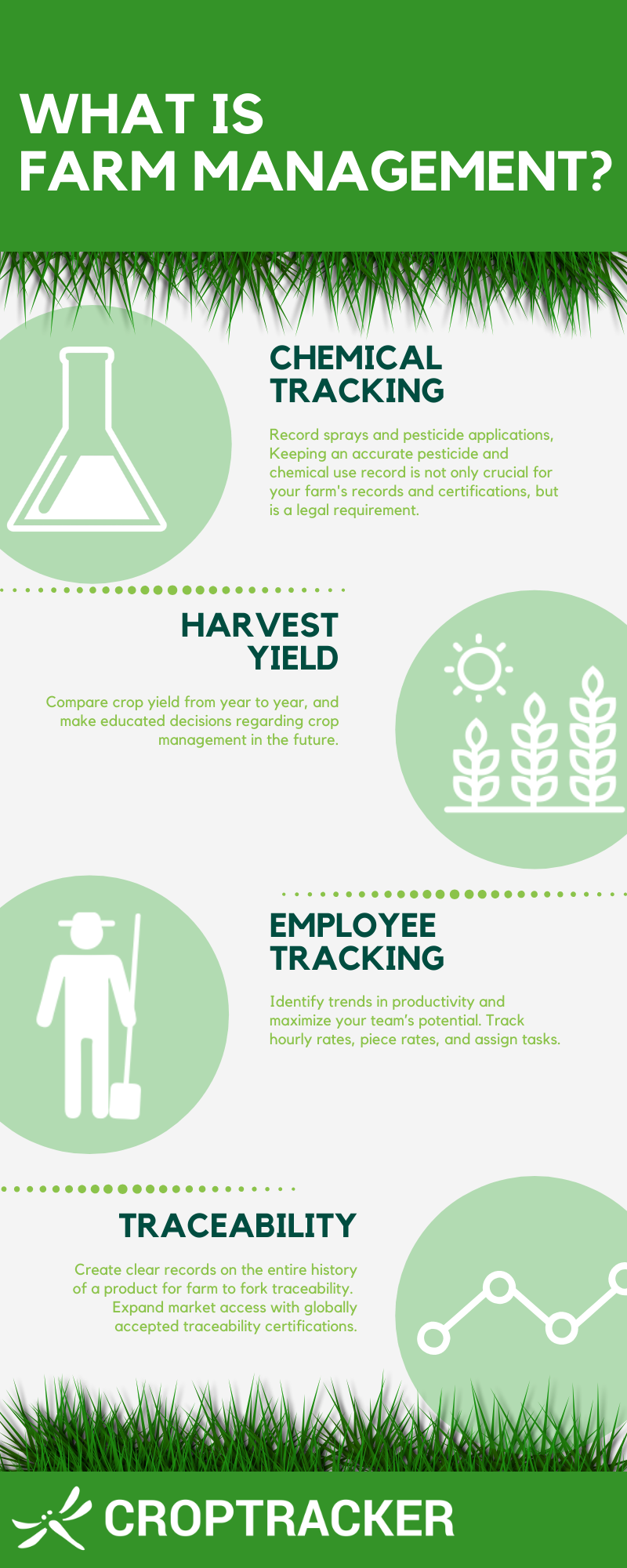
Don’t know how to get started? Croptracker is a farm management software system that is easy to use, scales with your business, and enhances traceability and record keeping for growers of all kinds.
Interested in learning more about Croptracker? Learn more about our Farm Management Software, or book a demonstration to schedule a meeting with our product experts.
And as always, if you're ever stuck, never hesitate to e-mail us at support@croptracker.com or Live Chat with us by clicking the green speech bubble ![]() in your bottom right-hand corner. We're always happy to help, so Croptracker can make your farm more efficient, safer, and more profitable!
in your bottom right-hand corner. We're always happy to help, so Croptracker can make your farm more efficient, safer, and more profitable!
Starch is a type of carbohydrate that is found in many plants, including fruits such as apples. In unripe apples, starch is the primary form of carbohydrate present, but as the fruit ripens, the starch is converted to sugar. The amount of starch present in an apple is one metric used to determine its level of ripeness, with more starch indicating that the fruit is less ripe.

The starch test used in apple harvesting is based on the principle that iodine reacts with starch to produce a blue-black color. By applying an iodine solution to a cut surface of an apple, the amount of starch present can be determined by the staining pattern of the color produced. Different apple varieties may require different levels of staining to indicate the appropriate level of ripeness, so it is important to use the appropriate chart for each variety.
Along with firmness, size, background and red coloration, and brix, the starch-iodine test is one of the main preharvest tests apple growers use to determine the ideal harvest window. A Starch Pattern Index (SPI) is a visual tool used to estimate the starch levels in the fruit using an iodine solution. To determine the ideal window, testing for starch levels should begin at least four weeks before the expected harvest date, and additional tests should be done at least once each week until the optimum harvest window is determined.
Starch testing is also a key step in organizing storage inventory on harvested apples. After a certain maturity level has been reached in harvested fruit, it is no longer viable for long-term storage. Apple storage and packing facilities that sell fruit from outside growers will test starch levels at receiving locations as part of their QC processes. Fruit with like starch levels will be grouped and stored together for packing later in the season.
Always follow the label instructions and wear appropriate personal protective equipment when handling and mixing chemicals. Avoid contact with eyes and skin, and wear gloves when preparing the iodine solution.
Warning. Iodine is a poisonous chemical. This iodine solution should be correctly labeled and kept away from children and pets. Consider treated apples poisonous and do not feed to any animal or use in composting.
Use a fresh batch of solution and apples that have been recently harvested. If the temperature of the apples, or of the iodine solution, is less than 10°C, inaccurate readings may result.
There are various instruction sets from governmental and academic institutions we used to compile these instructions including Virginia Cooperative Extension, Michigan State University, and the government of Ontario.

While the testing process remains the generally the same across the board, there are several scales used around the world to assess the results. Some scales are variety specific and some are general and meant to be applied accross multiple varieties.
The Cornell starch-iodine scale is scored out of 8 with one being the darkest stain, and therefore most starchy and least ripe, and eight representing the lightest, most ripe apples. This chart is favoured by many growers because it can be consitently applied across many varieties. It is also the most widely cited scale in studies about breeding, long term storage and harvest timing. Because of the varietal consistently and extensive testing, the Cornell scale is the scoring system used in Croptracker’s Starch Quality Vision system.
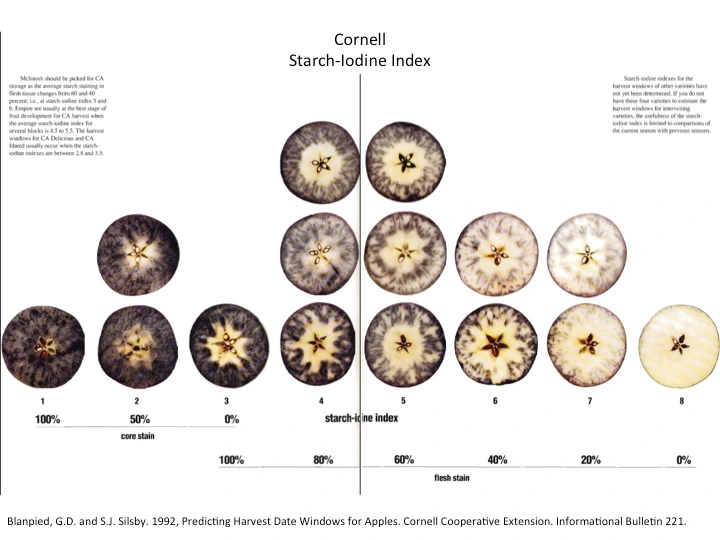
The CTIFL scale was developed in France with an emphasis on European cultivars specifically. It is often the scale used in harvest and storage reference guides for the Pink Lady/Cripps Pink variety. This chart uses the classic 10-stage scale and includes harvest window recommendations for several popular European varieties. The CTIFL starch scale system recognizes two staining patterns, the circular staining pattern, and the radial pattern which are applied to specific varities based on their common starch patterning.
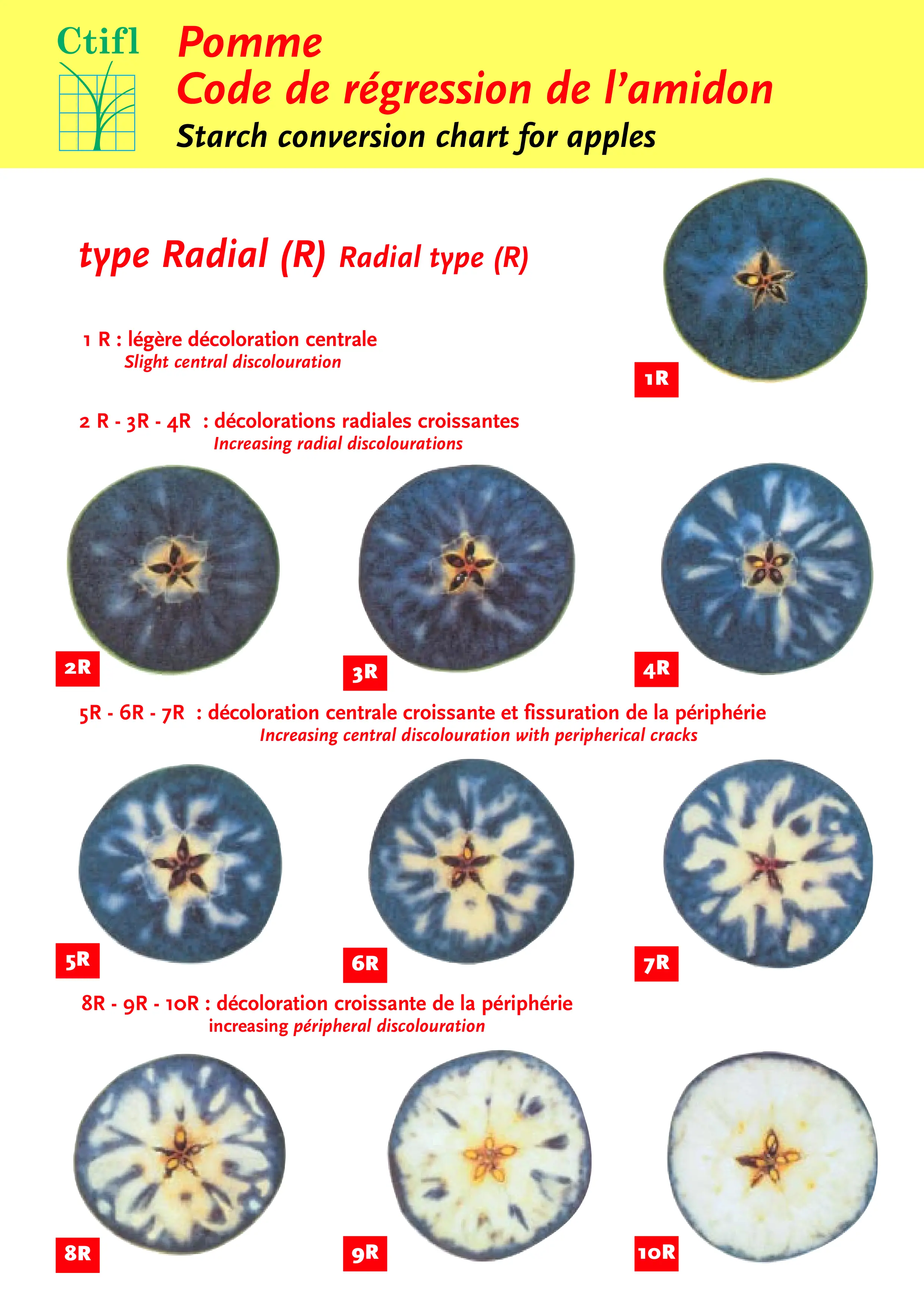
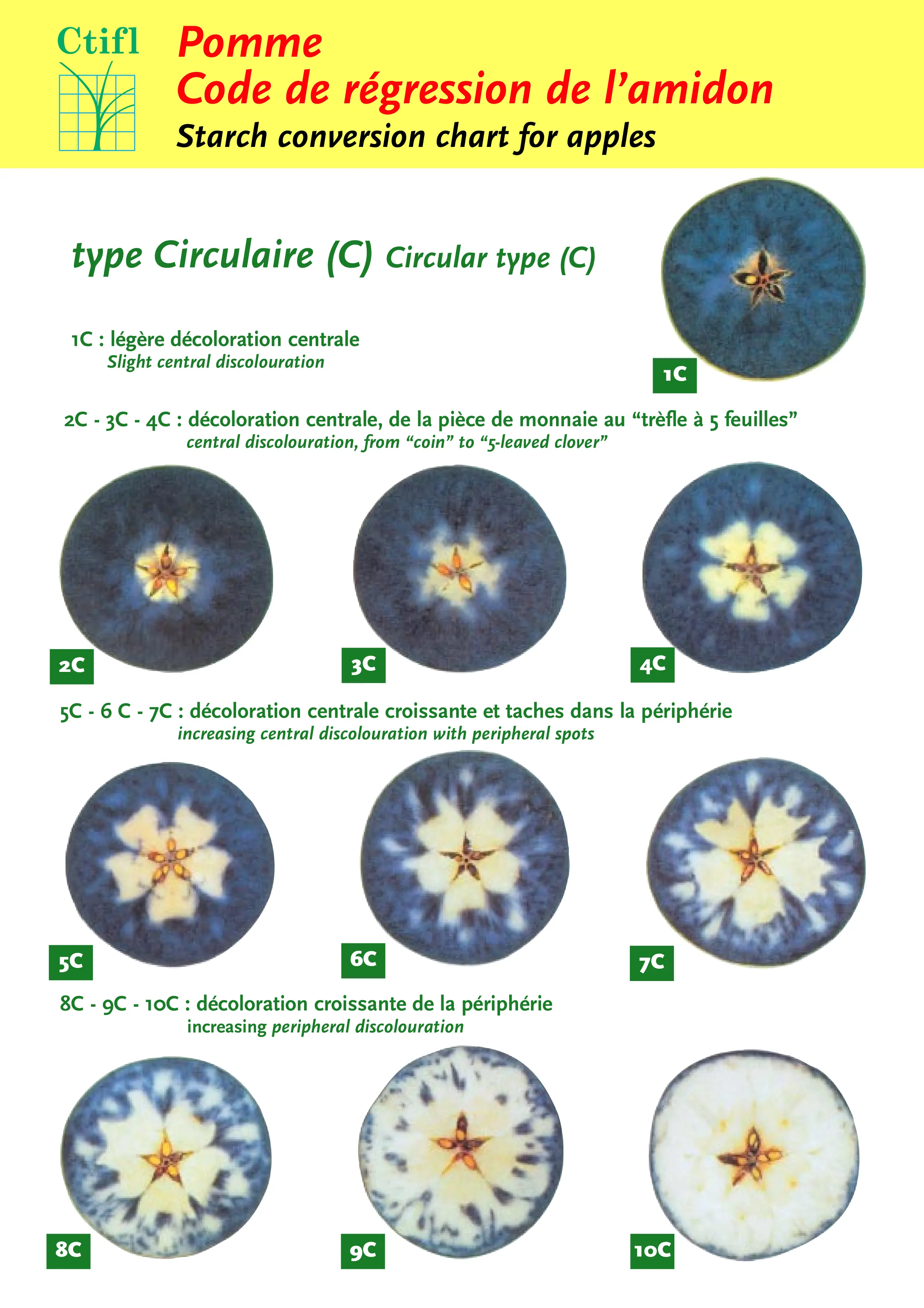
The Laimburg scale is a 1.0 - 5.0 ranking to one decimal place used almost exclusively in European regions around Germany, Austria and Northern Italy and was developed by the Laimburg Research Centre. The scoring key also includes examples of the halfway point between the 1-5 scores. In these regions, the score is often converted to a ten-point scale after grading for use in the Streif Index Method, which uses both pressure and brix as well as starch to calculate apple maturity.
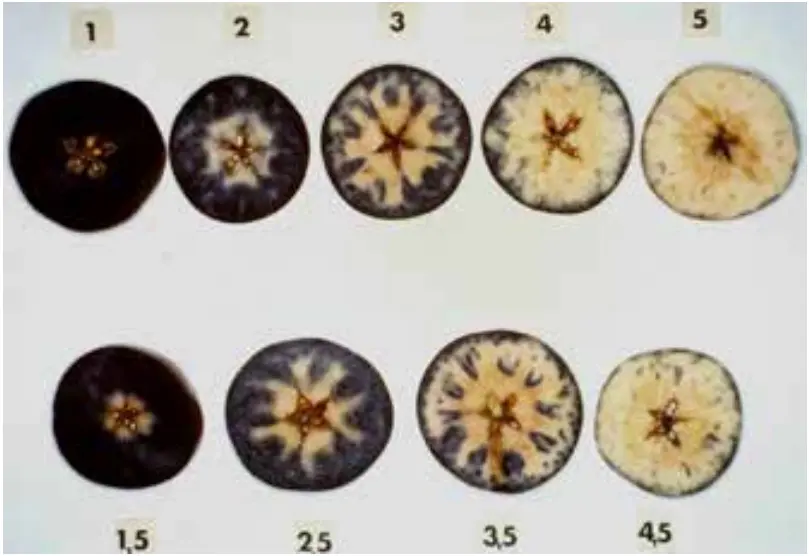
Not strictly speaking an SPI, the Streif index is calculated from the results of three quality control tests; a starch test, a pressure test, and a test of soluble solids concentration, or Brix. The Streif Index is meant to be a more thorough and accurate measure of maturity than using starch alone. Lower values mean the fruit is closer to maturity, and the Streif Index is particularly valuable not just as a tool to determine the start of harvest, but to determine the last possible date.
The equation F/(SSC x S) where F = Flesh firmness, SSC = Soluble Solids Concentration and S = Starch test results provides the Streif coefficient, which is then compared to the ideal values of individual varieties and regions.

The ever-popular Honeycrisp apple is a sensitive cultivar with very specific storage requirements. The Washington State Tree Fruit Research Commission has created a specific Honeycrisp starch index for these finicky apples, which stain in patterns inconsistent with the other varieties and starch scales.
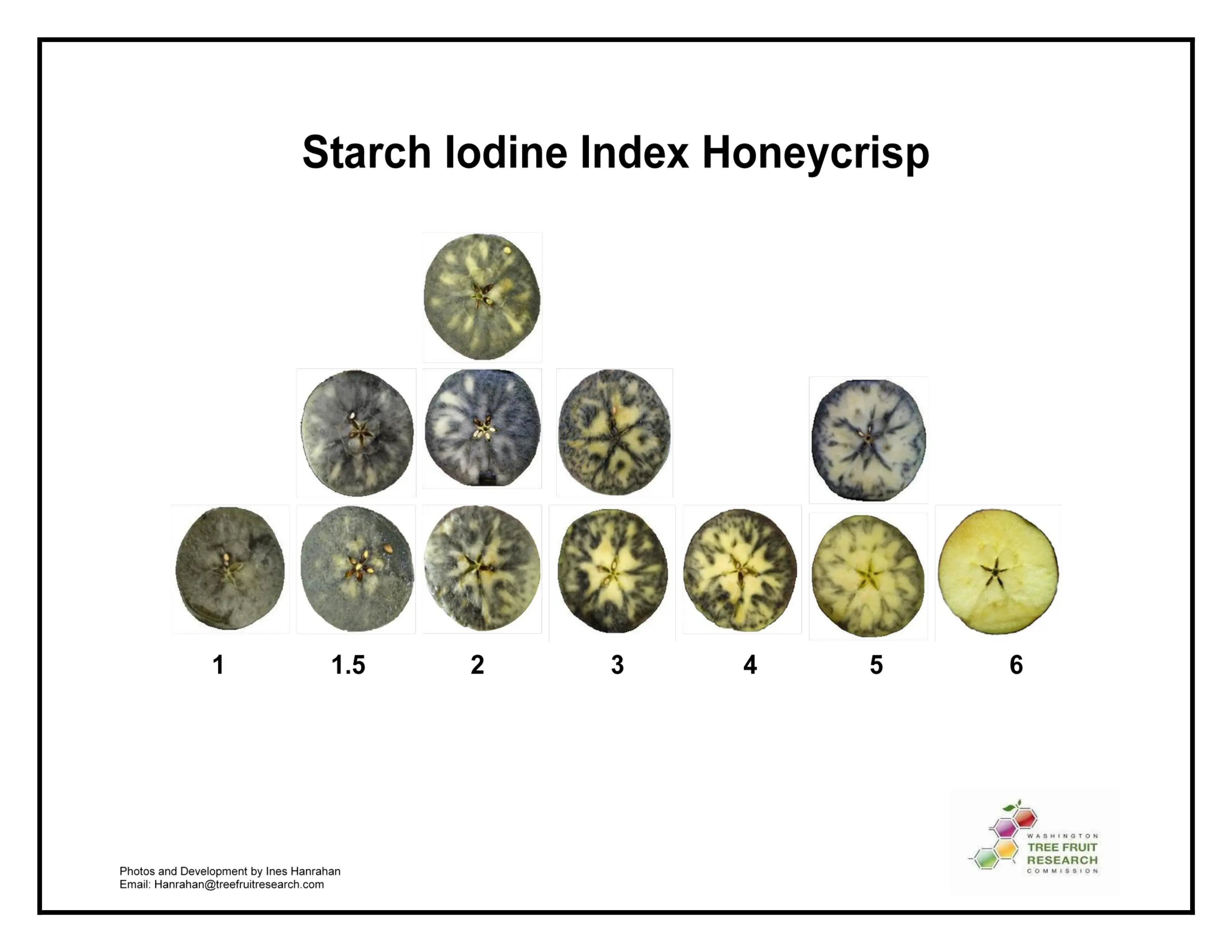
The WA38 Cosmic Crisp scale is a cultivar-specific scale designed for the unique staining pattern that occurs in cosmic crisp apples. This scale is out of six with a 0.5 interval and has two staining patterns to account for variability. There are extensive resources about growing Cosmic Crisp from the Washington Tree Fruit Research Commission to ensure the branded and IP-protected variety is consistent across growers, packers and markets.
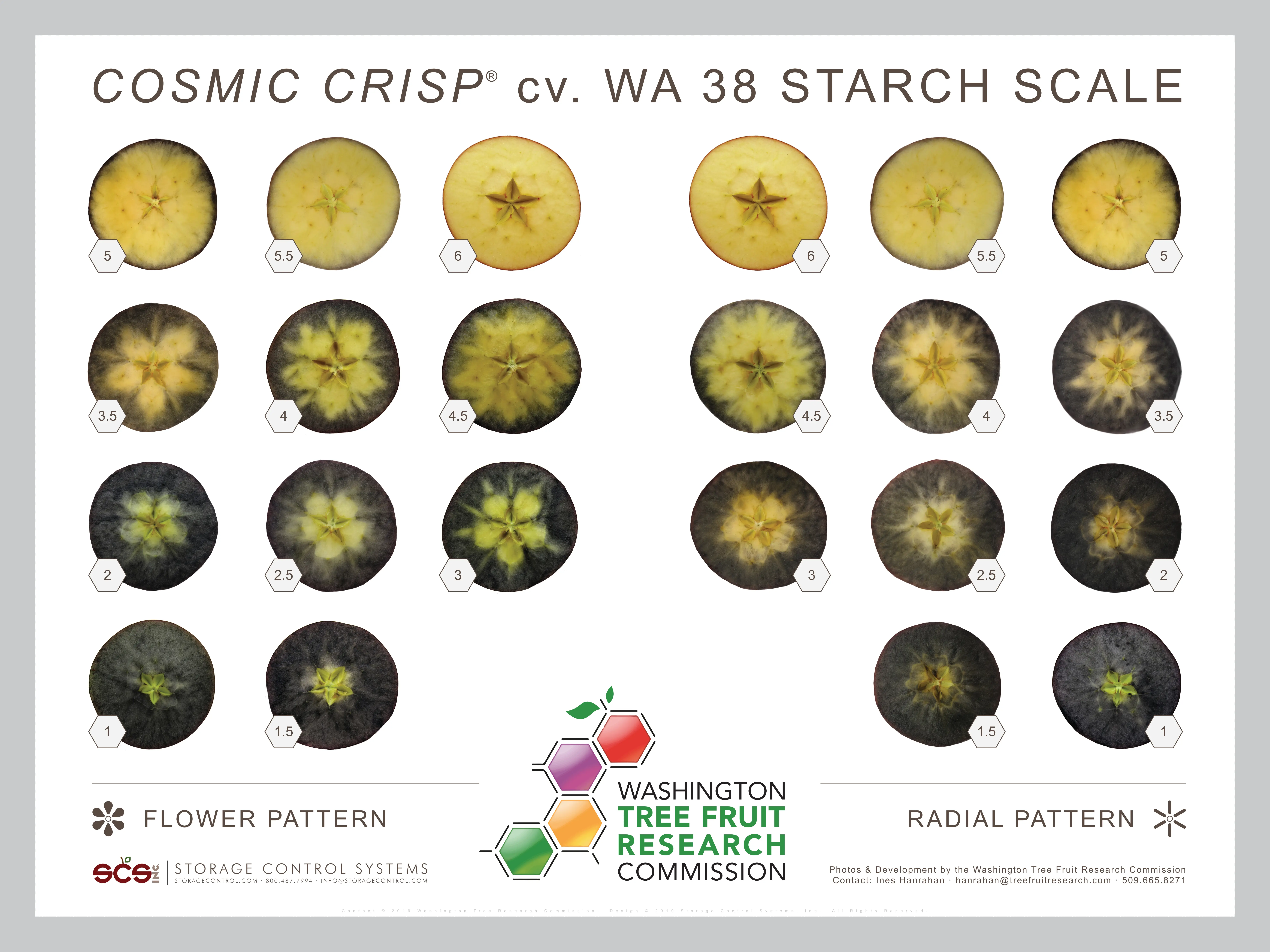
The Granny Smith scale was developed by the University of Southern California Davis Department of Pomology in cooperation with the California Granny Smith Apple Association (now known as the California Apple Commission). It is a scale from 1 to 6 with only whole numbers applied to individual scoring. It prompts testers to pay attention to key indicators in all regions of the apple cross-section, the skin, cortex, coreline, core and vascular bundles.
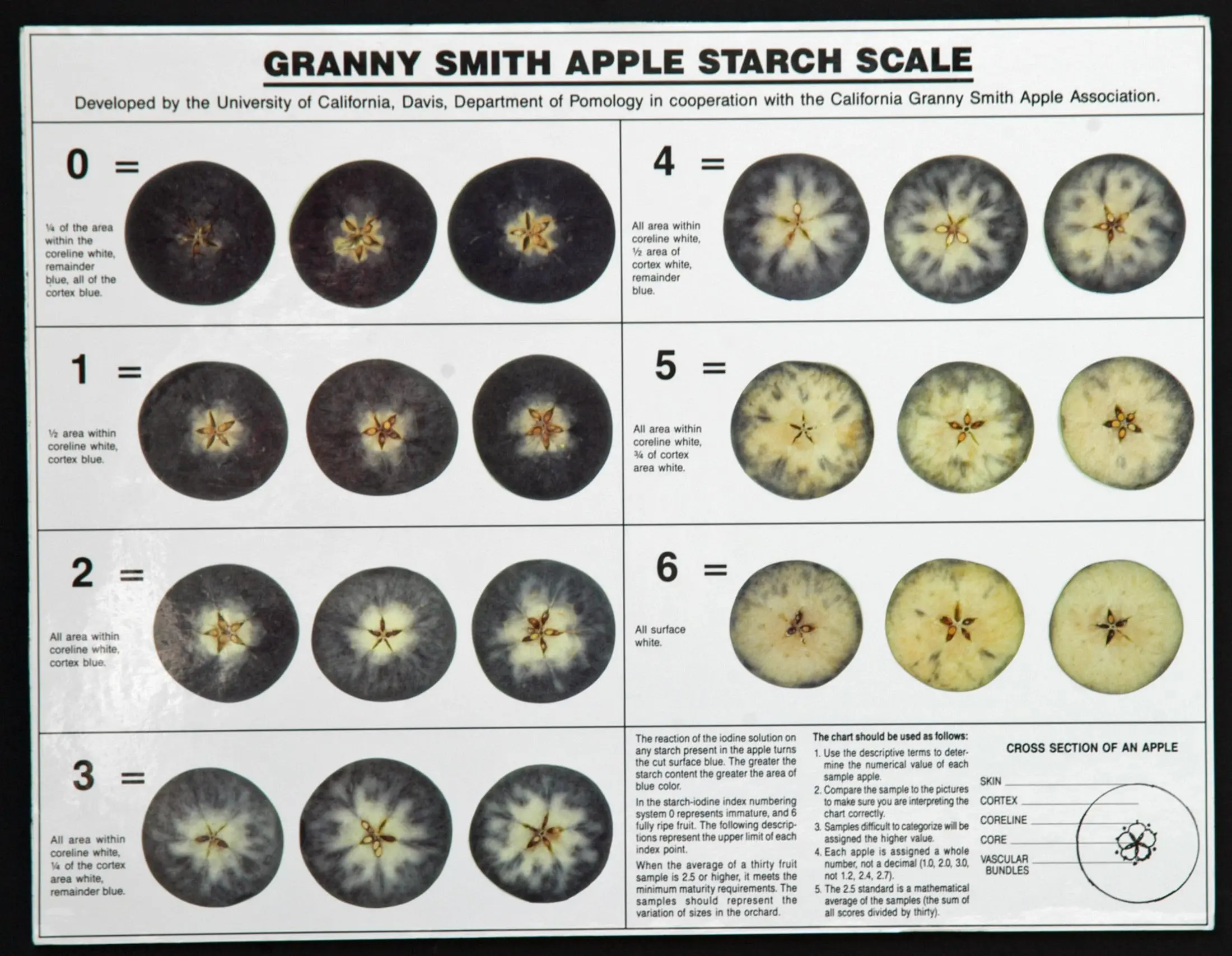
The Michigan State University Apple Maturity Program has perhaps one of the most complete and varietal-specific starch index scale guidelines. Their index contains specific scale references for the main commercial varieties in Michigan, including Ambrosia, Braeburn, Empire, Evercrisp, Fuji, Gala, Golden Delicious, Granny Smith, Honeycrisp, Idared, Jonagold, Jonathan, Pink Lady, Red Delicious, and Rome. The scales go from 1-7 or 1-8 depending on the variety and this guide contains recommended storage ranges for short and long-term storage. The 1-8 range aligns closely with the Cornell scale making it useful in comparisons to research done using the Cornell scale.
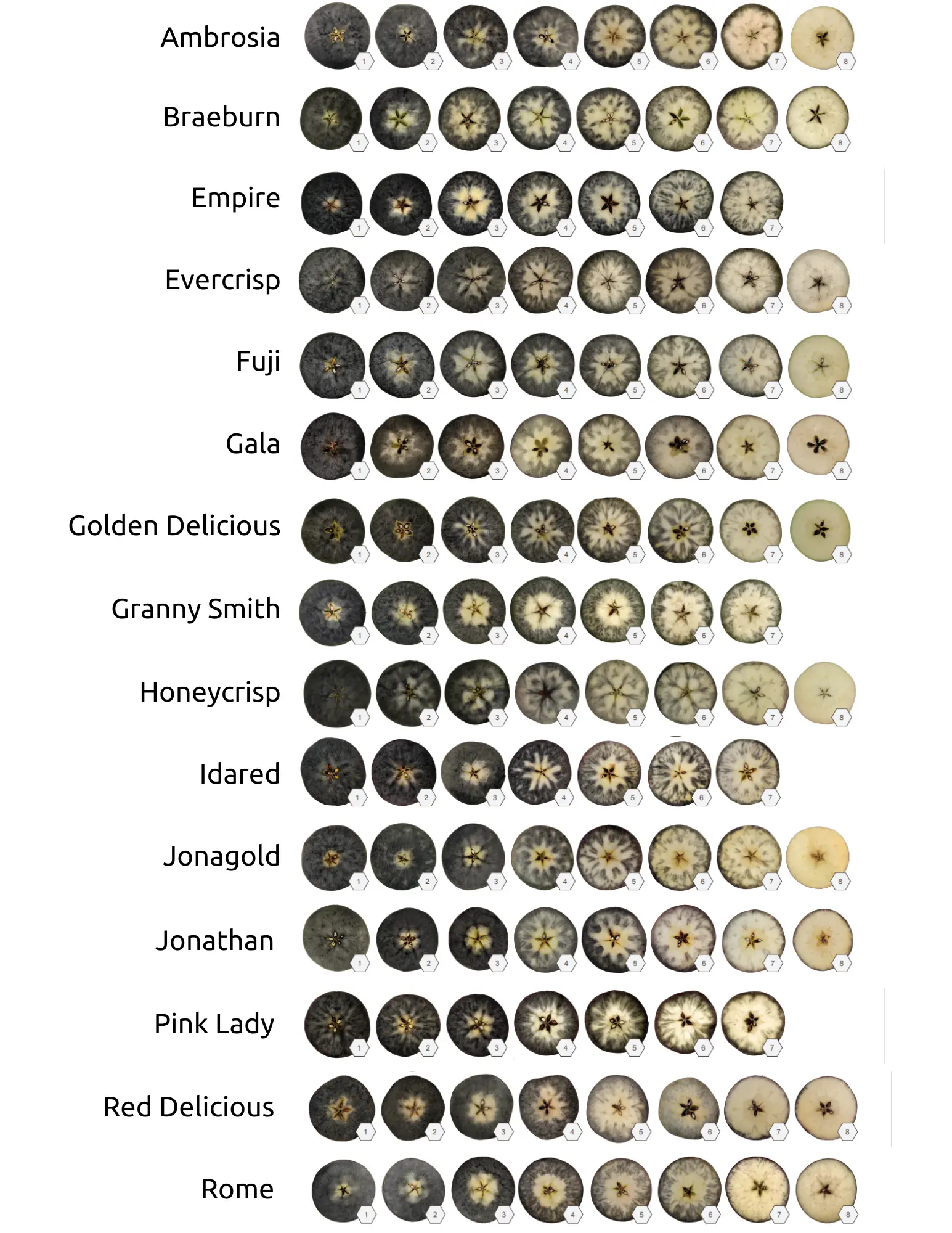
Developed in conjunction with Les Producteurs de pommes du Québec (Quebec Apple Growers Federation), the Quebec Agriculture and Agri-Food Reference Center and Engage Agro, this scale covers several varieties and is especially useful as it also includes storage guidelines. The table in the top right corner shows the starch and pressure ranges needed for each variety to quality for long-term, medium-term, and short-term CA storage and for cold storage and immediate sale. Similar to the Cornell scale, the score ranges from 1 to 8 but includes both Radial and Circular (Concentric) pattern examples.
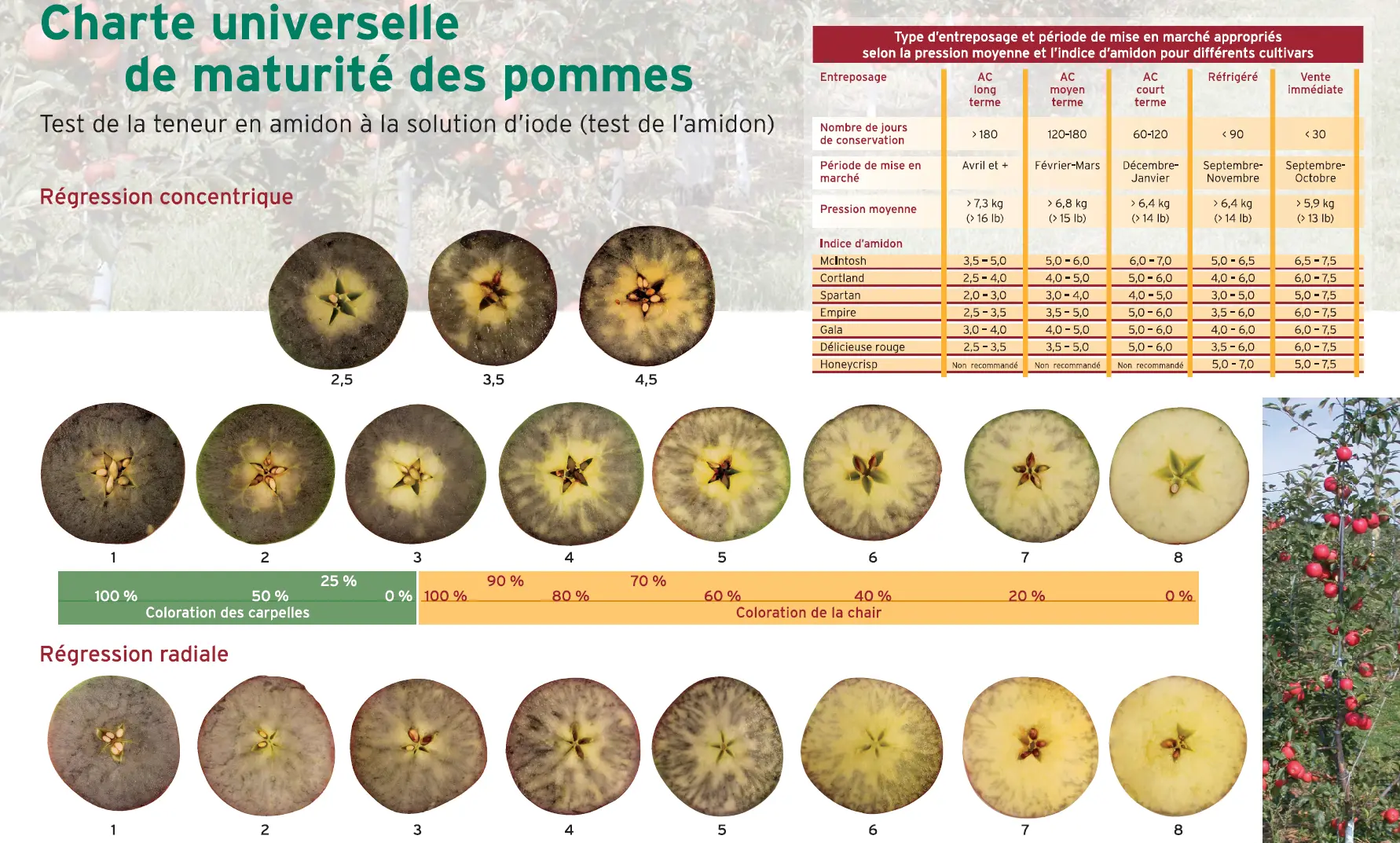
This scale was developed for use primarily in Australia and New Zealand, the ENZARUIT / Pip Fruit New Zealand (New Zealand Apples and Pears). It helpfully includes several examples for each score and ranges from 0 to 7 to accommodate different patterning tendencies. It includes some written descriptions of the size of the table for further clarification on the difference between the ranges and also suggests that growers use at least 20 apples per sample for meaningful results.
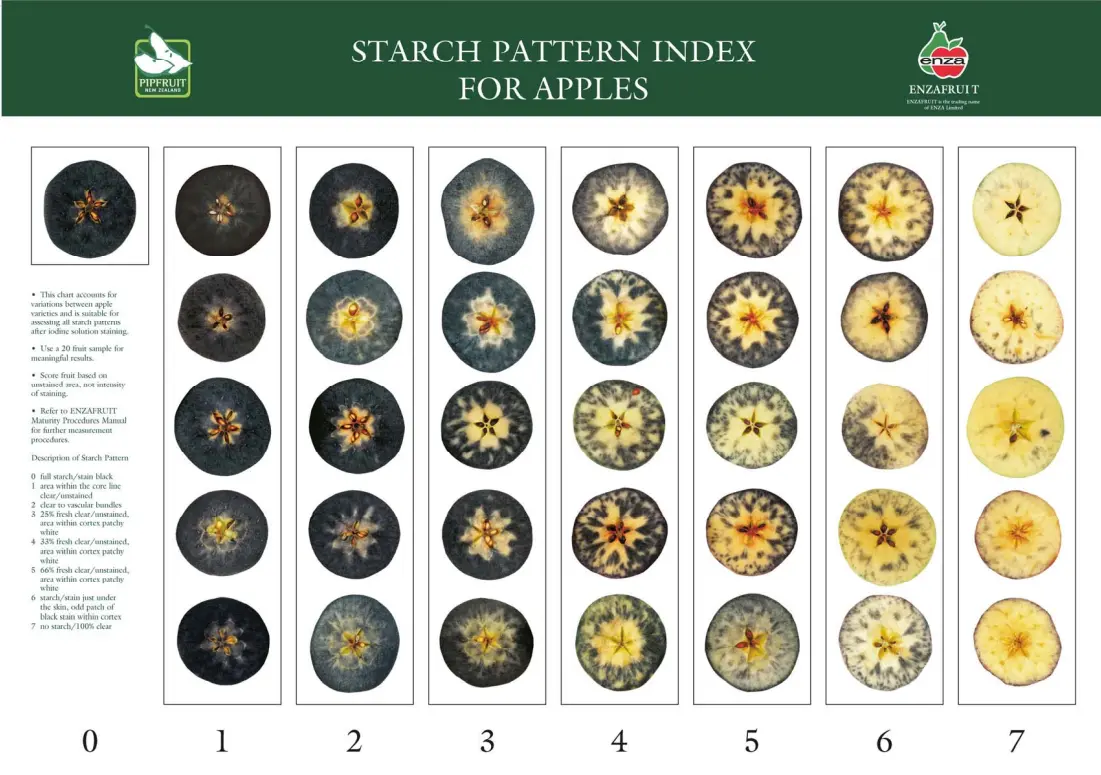
With so many variations in Starch Pattern Index scales and guidelines, it can be challenging to develop and maintain industry-level standards for grading. Many organizations develop their standards over the years. Internal guidelines used for their varieties can be a combination of the scales listed above and other regionally developed varietal scales.
Standards are also very difficult to develop in starch testing as the grading process is subjective. Two people using the same scale and looking at the same iodine-stained apple will not necessarily come up with the same score. Lighting, eyesight, and fatigue all play into how an individual assigns a starch score.
Several academic and industry studies have been done to assess the possibility of eliminating subjectivity through digital starch index assessment tools. Most of these tools use black-and-white imagery to determine how much white space vs iodine staining is present and assign a score based on this ratio. This method however fails to take into account the pattern variation that can impact a score significantly.
Croptracker’s Starch Quality Vision system uses pattern, color and stain ratio recognition to classify and score images in the app of iodine-tested apples on the Cornell scale. For more information on digital starch grading, check out the Starch Quality Vision page.
Detailed farm record keeping is crucial when making important business or planning decisions for your operation. Not only is it a poor business practice to not keep records of farming activities, but it can be illegal not to keep your records in order.
Farm records can include any of the following: expenses, labor, chemical/pesticide tracking, harvest and yield records, planting records, shipping records, FSMA and GlobalGAP compliance records, and more.
Traceability plays a huge role in practicing safe farming, as it is always important to be able to look back and see the full history of product, from planting to shipping. Keeping your records in good order will vastly simplify this process, and make auditing season a breeze.
At a minimum, growers must keep records to comply with legal requirements for taxes and restricted chemical use applications, but additional record keeping is a valuable tool. Many growers track their expenses, from equipment runtime, to labor costs, to chemical and fertilizer costs. Tracking labor, equipment, and chemical costs enable you to make informed decisions when pricing your products to ensure greater profits.
Harvest yield records can be used to compare crop yield from year to year, to help growers make educated decisions regarding crop management in the future. You can’t manage what you can’t measure, so record keeping around harvest quantity is essential to growers tracking their income against cost of production.
Pesticide and Spray records are absolutely essential for both food and worker safety. Records of spray dates, chemicals used, and safety intervals suchs as the re-entry interval and the pre-harvest interval protect your customers and employees from exposure to potentially harmful residues. In many countries, chemical use reporting is mandatory to comply with regulations around food and environmental safety. Chemical use tracking is also a key part of tracking overall farm expenses.
Labor Tracking and worker productivity records are an aspect of record keeping that are essential for managing payroll and piecemeal payouts for your farm workers. More efficient payroll record keeping can save valuable time and money by speeding up the payroll process. Effectively tracking piece-rates for harvest can motivate workers, and make assessing overall productivity easier.
Many farms that employee temporary foreign workers are legally obligated to track not only hours worked, but hours offered to their employees, in addition to the usual hourly and overtime tracking, and to maintain detailed records of all employee activities on the farm.
Food safety and traceability are a growing concern for growers and consumers worldwide. The Global Food Safety Initiative, or GFSI, established in 2000 sets global food safety standards, and certifications that demonstrate that produce has passed its rigorous food safety standards. Global Good Agricultural Practices (G.A.P.) is the most widely used international standard for farm production, and includes standards for food safety and traceability, environmental protection, worker safety and welfare, animal welfare, and more.
Produce sold in the USA must additionally meet the FDA’s Food Safety Modernization Act (FSMA) standards.
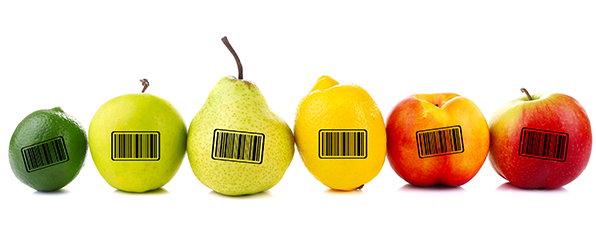
To meet these standards, a rigorous auditing and record keeping system is required, to ensure safety and traceability of products being sold to consumers worldwide. Effective record keeping is also a must for an easy auditing season. The more accurate and precise records you have available for an auditor, the quicker and easier the process will be.
Regulations for food safety and record keeping can vary depending on the region. Chemical application laws for instance, are established regionally.
In the United States pesticide use is restricted by the 1990 Farm Bill which states that “all private applicators (those who apply pesticides to their own land) must maintain records of restricted-use pesticide (RUP) applications.”
In the EU, a comprehensive body of legislation regulates the use of plant protection products such as pesticides and their residues in food. Maximum Residue Levels, or MRLs, are the upper limit of chemical residues on food as set by the European Food Safety Authority (EFSA).
In New Zealand, agrichemicals are controlled as hazardous substances and must be used in such a way as to minimize environmental effects.
In Canada, chemical and pesticide use are regulated federally, with additional regulations at the provincial level if applicable. Canada GAP certification requires detailed record keeping for all agricultural chemical purchasing and receiving, application and storage.
The importance of record keeping regarding chemical and pesticide use cannot be overstated for growers of commercial fruit and vegetables.
When applying for grants or loans, whether as a small farm or a large business, detailed financial information and records are often required, either to determine eligibility or to prove that a farm is financially stable. Financial records, income statements, and expenses should all be up to date. Tracking farm income and expenses isn’t just important for your bank records though, good records will help you determine profits and identify any inefficiencies in your business.
In addition to the classic paper record keeping, there has been a recent trend for farmers to go digital with their record keeping, using spreadsheets, orchard management software, or farm management software to manage the extensive data collection they need.
Digital record keeping can range from simple excel spreadsheets and basic calculations to online data management tools.
Another popular trend in farm record keeping is the use of farm management apps. Farm management apps and other apps for farmers aim to make farm record keeping easier and more reliable using digital recording, with records often stored in the cloud for easy access from anywhere. Farm management apps range in complexity, from simple mobile farm record keeping spreadsheets to fully integrated recording systems stretching from planting to sale.
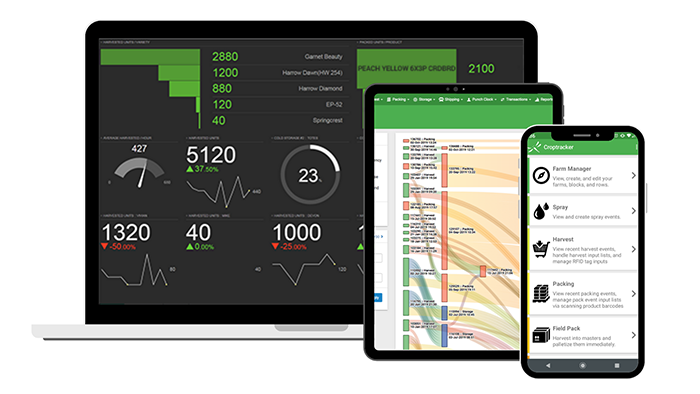
Keeping accurate farm records is crucial to growers who want to measure their efficiency and progress throughout the year. With comprehensive records, time spent on administrative work such as payroll and audits can be drastically reduced.
Better records also mean a better understanding of the strengths, weaknesses, and productivity levels around the farm, and can provide insight into best practices going forward. Food safety and traceability, topics at the forefront of the consumer consciousness, can be enhanced exponentially with effective recording processes.
Organized record keeping can cut audits down from a few days to a few hours, and these audits can allow growers to achieve food safety certifications, which in turn expand market access.
Data collection drives growth - as long as you can understand what your data is telling you.
Interested in learning more about Croptracker? Learn more about our Farm Management Software, or book a demonstration to schedule a meeting with our product experts.
And as always, if you're ever stuck, never hesitate to e-mail us at support@croptracker.com or Live Chat with us by clicking the green speech bubble ![]() in your bottom right-hand corner. We're always happy to help you make the most of Croptracker to make your farm more efficient, safer, and more profitable!
in your bottom right-hand corner. We're always happy to help you make the most of Croptracker to make your farm more efficient, safer, and more profitable!
Let our expert staff walk you through the Croptracker system, and answer any questions you have.
We are here to help.